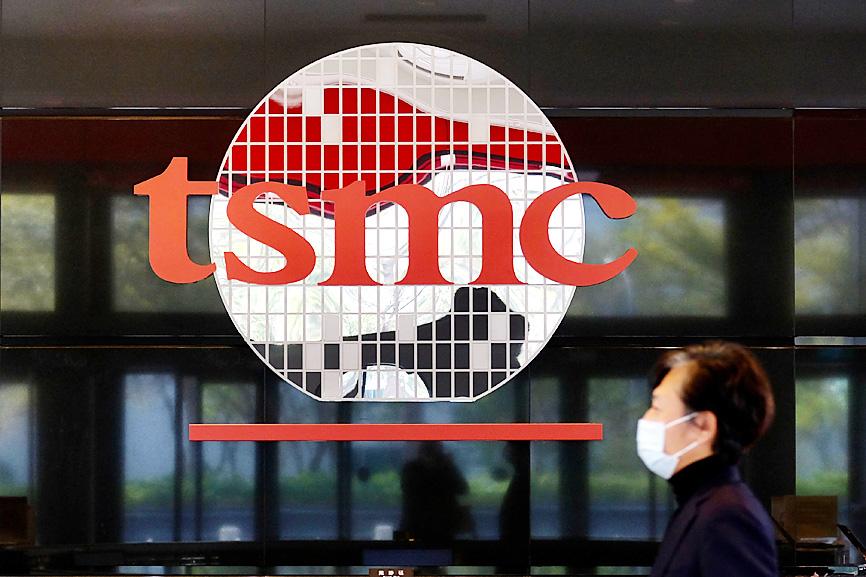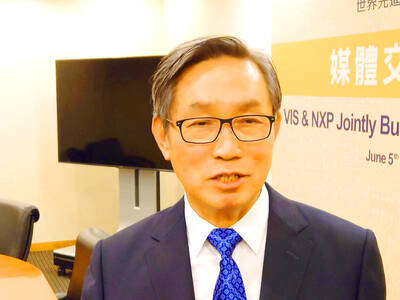Taiwan Semiconductor Manufacturing Co (TSMC, 台積電) yesterday said that revenue would grow at least 10 percent sequentially this quarter to another record high, driven primarily by increasing demand for advanced chips used in 5G-related and high-performance computing applications.
The Hsinchu-based chipmaker expects no quick fix to an ongoing worldwide chip shortage, saying that its capacity would remain tight at least through the end of this year.
TSMC is therefore “firming up” pricing to reflect higher manufacturing costs, it said.

Photo: Sam Yeh, AFP
“The semiconductor capacity shortage is driven by structural increases in long-term market demand and short-term imbalance in the supply chain due to COVID-19-induced uncertainty and political tensions,” TSMC chief executive officer C.C. Wei (魏哲家) told investors during an online earnings conference yesterday.
However, global automakers would profit from TSMC’s increased output of microcontroller units (MCU) later this quarter, it said.
Production of the key component for vehicles would expand 30 percent in the second half of this year from the first half, it said.
Annually, MCU output would grow about 60 percent from last year, TSMC added.
Revenue this quarter is to expand to US$14.6 billion to US$14.9 billion, compared with NT$372.16 billion (US$13.34 billion) in the second quarter, driven by solid demand for chips for smartphones, high-performance computing, vehicles and Internet-of-Things applications, TSMC said.
For the whole of this year, revenue is expected to grow more than 20 percent annually, the chipmaker said.
TSMC also raised its revenue growth forecast for the global semiconductor industry excluding the memorychip sector to 17 percent, compared with 12 percent estimated three months ago.
In the second quarter, TSMC’s net profit expanded 11.2 percent to NT$134.36 billion from NT$120.82 billion a year earlier, but declined 3.8 percent from NT$136.69 billion in the first quarter.
Earnings per share were NT$0.94, up from NT$0.78 a year earlier, but down from NT$0.96 in the first quarter.
The chipmaker forecast that gross margin would improve to about 50.5 percent this quarter, from 50 percent last quarter, underpinned by improved back-end service business and offsetting unfavorable foreign exchange rates.
To meet customer demand, TSMC said it is expanding capacity at its fab in Nanjing, China, by 60 percent to 40,000 wafers per month, adding that it would not rule out further expansions at the fab or starting phase 2 capacity expansion at its Arizona fab.
“Our customers welcome our capacity expansion in the US, and pledge strong support and business commitment. Therefore, we do not rule out the possibility of second-phase expansion to meet our customers’ strong demand,” TSMC chairman Mark Liu (劉德音) said.
TSMC is planning to increase its investment in Arizona by US$8 billion in the next three years, the company said.
“As the need for semiconductor infrastructure security has increased in recent years, we are expanding our global manufacturing footprint to sustain and enhance our competitive advantages, and to better serve our customers in the new geopolitical environment,” Liu said.
TSMC is also in the process of evaluating building a wafer fab in Japan to offer specialty technologies to customers there, in addition to a new chip packaging research and development center, the company said.
However, the chipmaker did not include any 3D chip packaging fabs in its expansion plans, neither in Japan nor in the US, as several media reported last month.

STEEP DECLINE: Yesterday’s drop was the third-steepest in its history, the steepest being Monday’s drop in the wake of the tariff announcement on Wednesday last week Taiwanese stocks continued their heavy sell-off yesterday, as concerns over US tariffs and unwinding of leveraged bets weighed on the market. The benchmark TAIEX plunged 1,068.19 points, or 5.79 percent, to 17,391.76, notching the biggest drop among Asian peers as it hit a 15-month low. The decline came even after the government on late Tuesday authorized the NT$500 billion (US$15.2 billion) National Stabilization Fund (國安基金) to step in to buoy the market amid investors’ worries over tariffs imposed by US President Donald Trump. Yesterday’s decline was the third-steepest in its history, trailing only the declines of 2,065.87 points on Monday and

TAKING STOCK: A Taiwanese cookware firm in Vietnam urged customers to assess inventory or place orders early so shipments can reach the US while tariffs are paused Taiwanese businesses in Vietnam are exploring alternatives after the White House imposed a 46 percent import duty on Vietnamese goods, following US President Donald Trump’s announcement of “reciprocal” tariffs on the US’ trading partners. Lo Shih-liang (羅世良), chairman of Brico Industry Co (裕茂工業), a Taiwanese company that manufactures cast iron cookware and stove components in Vietnam, said that more than 40 percent of his business was tied to the US market, describing the constant US policy shifts as an emotional roller coaster. “I work during the day and stay up all night watching the news. I’ve been following US news until 3am

Six years ago, LVMH’s billionaire CEO Bernard Arnault and US President Donald Trump cut the blue ribbon on a factory in rural Texas that would make designer handbags for Louis Vuitton, one of the world’s best-known luxury brands. However, since the high-profile opening, the factory has faced a host of problems limiting production, 11 former Louis Vuitton employees said. The site has consistently ranked among the worst-performing for Louis Vuitton globally, “significantly” underperforming other facilities, said three former Louis Vuitton workers and a senior industry source, who cited internal rankings shared with staff. The plant’s problems — which have not

TARIFF CONCERNS: The chipmaker cited global uncertainty from US tariffs and a weakening economic outlook, but said its Singapore expansion remains on track Vanguard International Semiconductor Corp (世界先進), a foundry service provider specializing in producing power management and display driver chips, yesterday withdrew its full-year revenue projection of moderate growth for this year, as escalating US tariff tensions raised uncertainty and concern about a potential economic recession. The Hsinchu-based chipmaker in February said revenues this year would grow mildly from last year based on improving supply chain inventory levels and market demand. At the time, it also anticipated gradual quarter revenue growth. However, the US’ sweeping tariff policy has upended the industry’s supply chains and weakened economic prospects for the world economy, it said. “Now